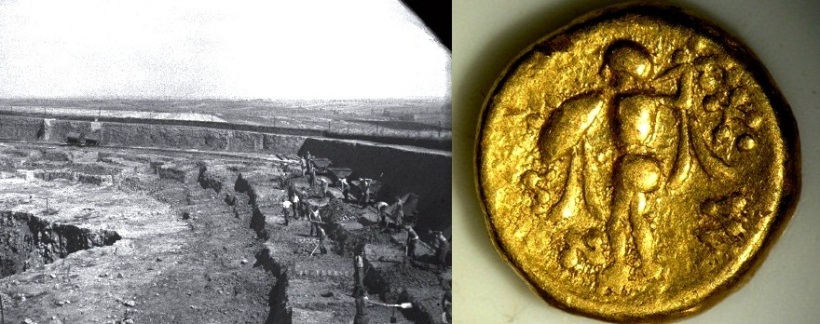UD: November 2019
Situated in the Opole district of Upper Silesia in Southern Poland, the Celtic center at Nova Cerekwia is located in a broad depression between the Sudetesland and the Carpathians – the Moravian Gate, which throughout antiquity served as a major communication route linking southern Europe and the Baltic Sea – commonly referred to as the Amber Route. Over the past century the site has attracted the attention of numerous researchers, both amateur and professional.
The site at Nowa Cerekwia
Location of Nowa Cerekwia
In the pre-WW2 era the site was investigated by German archaeologists in the 1925-1938 period, notably by the extreme right-wing B. Von Richtofen (Richthofen 1926, 190–191; Richthofen 1927; Jahn 1931, 66–78, 148–149; Petersen 1935), during which period discoveries included a pottery kiln, 11 houses, six pits and a hearth, although other accounts from the period indicate that as many as 30 Celtic pit-houses may have been excavated at the settlement (Rudnicki 2014). Initial indications are that the settlement thrived between the 3rd and 1st centuries BC.
Celtic pottery kiln excavated at the site in 1925
Excavations at the Nova Cerekwia site in 1936
Bronze fibulae and fragment of amber discovered during recent excavations of the Celtic settlement at Nowa Cerekwia (different scales)
While a number of studies were undertaken at the site by Polish archaeologists in the post-war era (1957–1962, 1971 and 1973; Czerska 1959; 1960; 1976), due to the haphazard nature of research, and the fact that only a small proportion of the material was published, the full extent of the complex at Nova Cerekwia remained unclear. Indeed, until recently it had been believed that all available material pertaining to the Celtic settlement had been uncovered.
This misconception has been clarified over the past decades by the discovery of a wealth of new material by local ‘treasure hunters’, particularly due to the efforts of the local historians Igor Murawski and Anna Brzezinska, a phenomenon which finally prompted archaeologists to renew research at the site resulting in the discovery of new structures as well as extensive numismatic and archaeological material (Rudnicki 2014).
Celtic artifacts discovered by the historians Igor Murawski and Anna Brzezinska at the site
https://balkancelts.wordpress.com/2013/02/09/the-celts-in-poland/
 Celtic coinage uncovered at the site
Celtic coinage uncovered at the site
Such recent finds have further confirmed Nova Cerekwia as one of the most significant archaeological sites in this area of Poland, indicating that it was a major settlement and center of inter-regional trade during the Celtic period. It is to be hoped that future systematic excavations at the site will finally establish the full extent of what promises to be the most important Celtic political/economic complex in this part of Europe.
For an overview on the Celts in Poland:
https://balkancelts.wordpress.com/2013/02/09/the-celts-in-poland/
Literature Cited
Czerska B. (1959), Osada z okresu późnolateńskiego koło Nowej Cerekwi w powiecie Głubczyce, ArchSl, 3, z. 18, 25–72.
Czerska B. (1960), Z badań wykopaliskowych na późnolateńskiej osadzie kultury celtyckiej w Nowej Cerekwii, pow. Głubczyce w 1960 roku, SSA, III, 7–12.
Czerska B. (1963) Wyniki badań późnolateńskiej osady kultury celtyckiej koło Nowej Cerekwi, pow. Głubczyce w latach 1958–1960, WA, 29/3, 289–311.
Czerska B. (1964) Sprawozdanie z badań osady celtyckiej w Nowej Cerekwi, pow. Głubczyce, w 1962 roku, SprArch, XVI, 124–131.
Czerska B. (1976) Osada celtycka koło wsi Nowa Cerekwia w powiecie Głubczyce w świetle najnowszych badań, StudiaArch, 7, 95–137.
Jahn M. (1933) Die älteste Münze aus Oberschlesien, IN: Matthes, W.–Raschke, G. (Hrsg.), Germanische Urzeit in Oberschlesien, Aus Oberschlesiens Urzeit, 20, Oppeln, 61–62.
Petersen E., Schlesien von der Eiszeit bis ins Mittelalter. Einfьhrung in die Vorund Frьhgeschichte des Landes, Berlin–Leipzig.
Von Richthofen B. (1926) Neue Ergebnisse der Vorgeschichtsforschung in Oberschlesien, Altschlesien, 1, 3–4, 185–198.
Von Richthofen B. (1927) Einfьhrung in die ur- und frьhgeschichtliche Abteilung des Museum Ratibor, Ratibor.
Rudnicki M. (2014) Nowa Cerekwia. A Celtic Centre for Craft and Commerce of Interregional Importance North of the Carpathians. In: Iron Age Crafts and Craftsmen in the Carpathian Basin Proceedings of the International Colloquium from Targu Mureş 10–13 October 2013. Targu Mureş 2014. pp. 33-70
Mac Congail



























